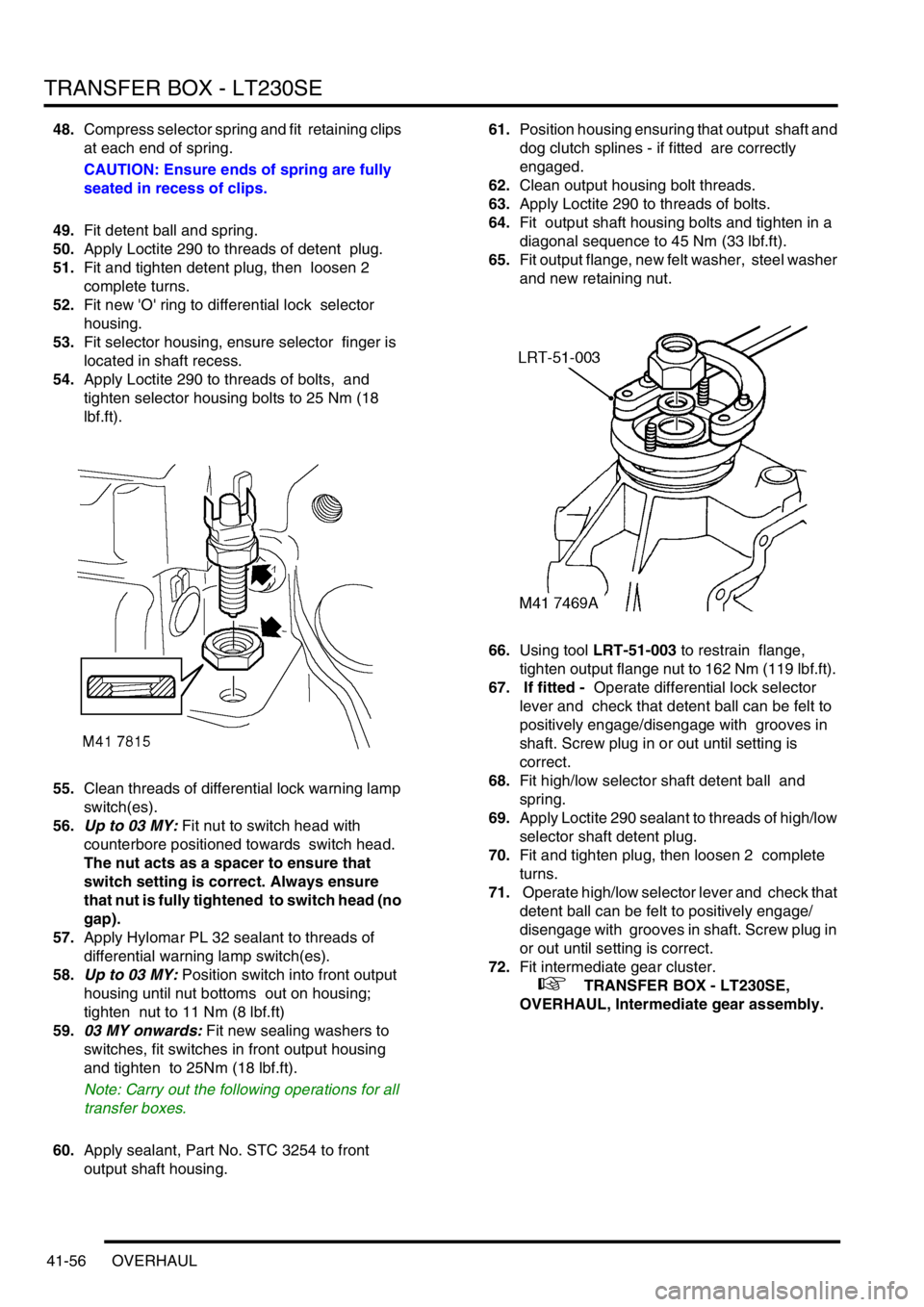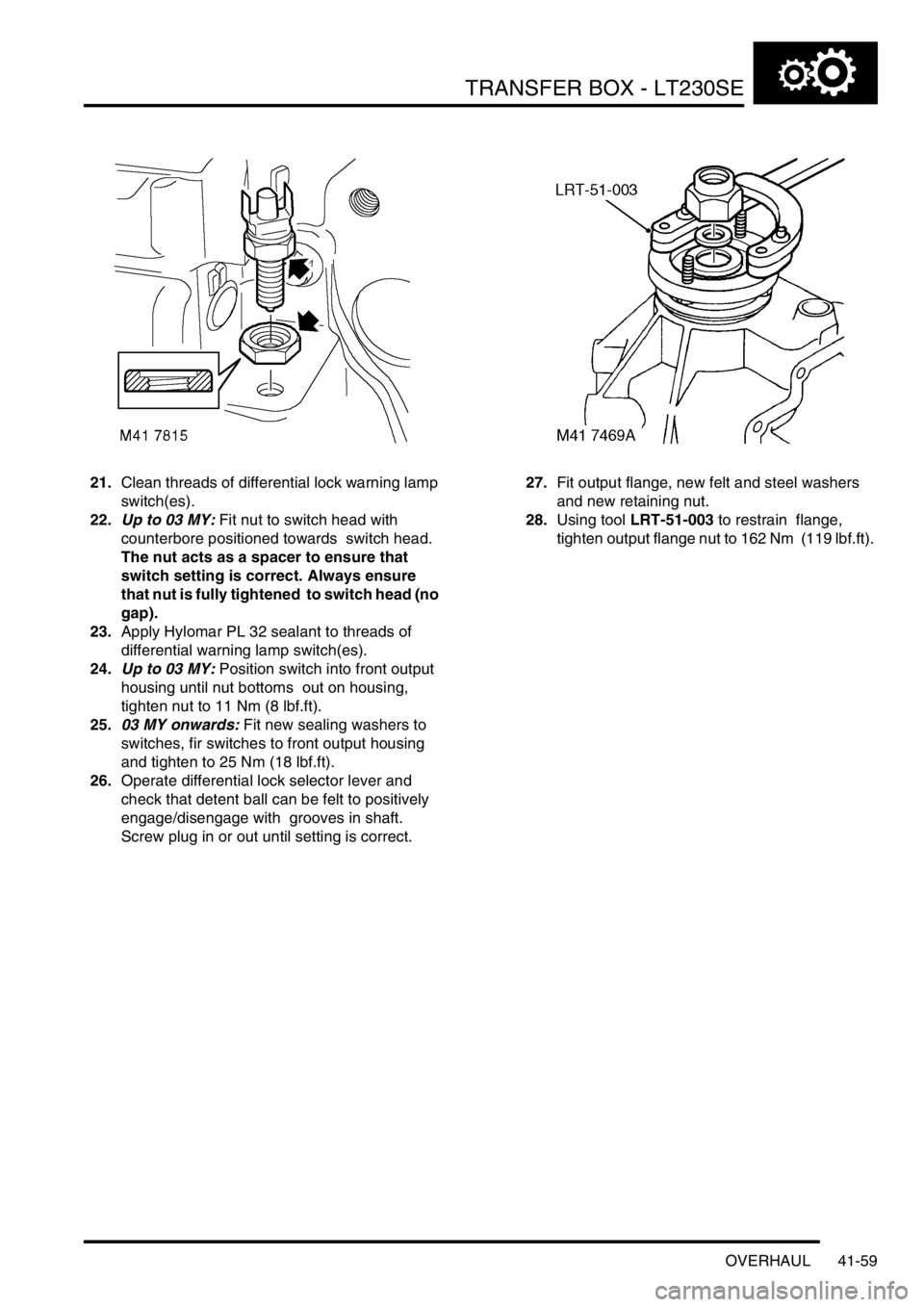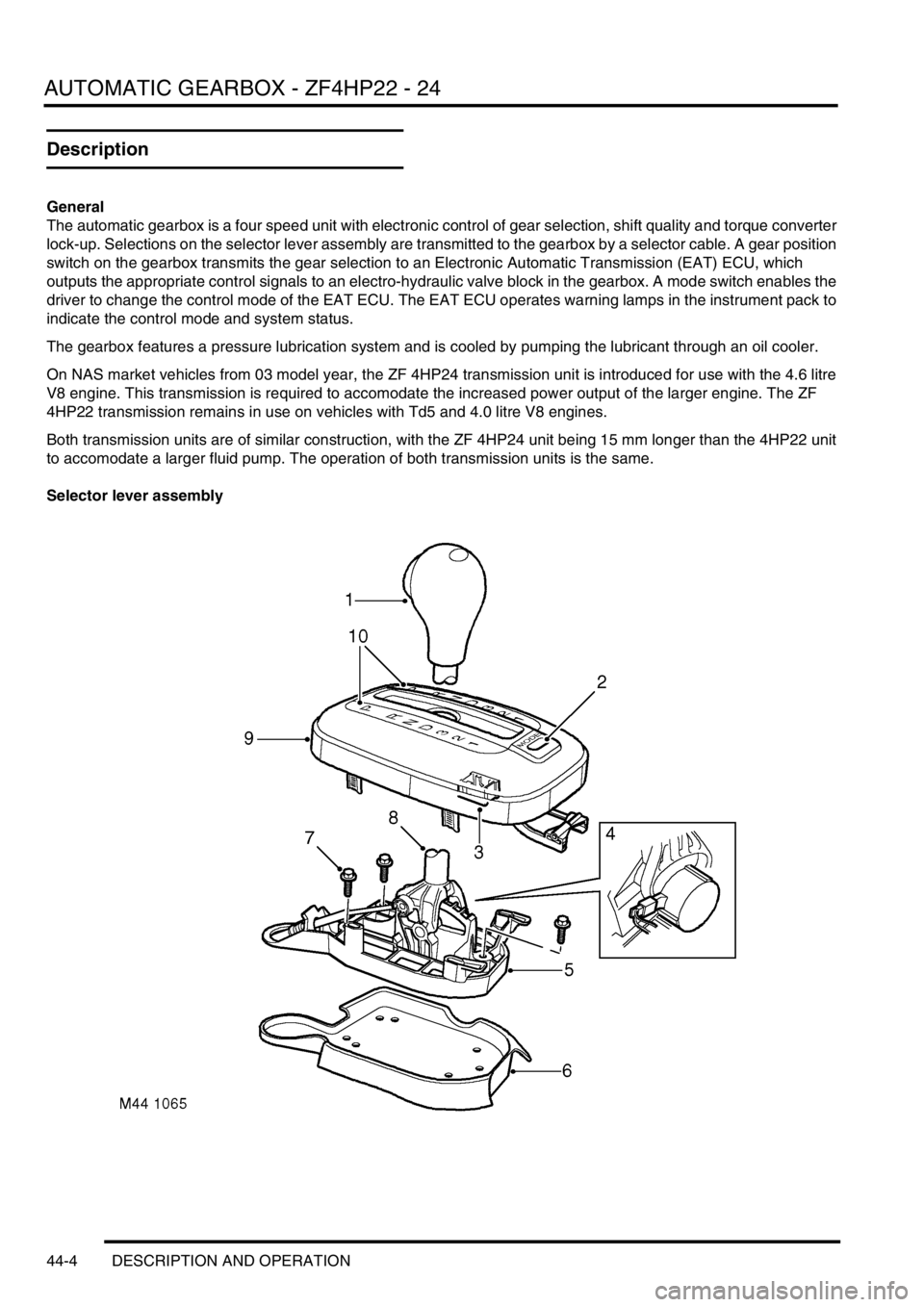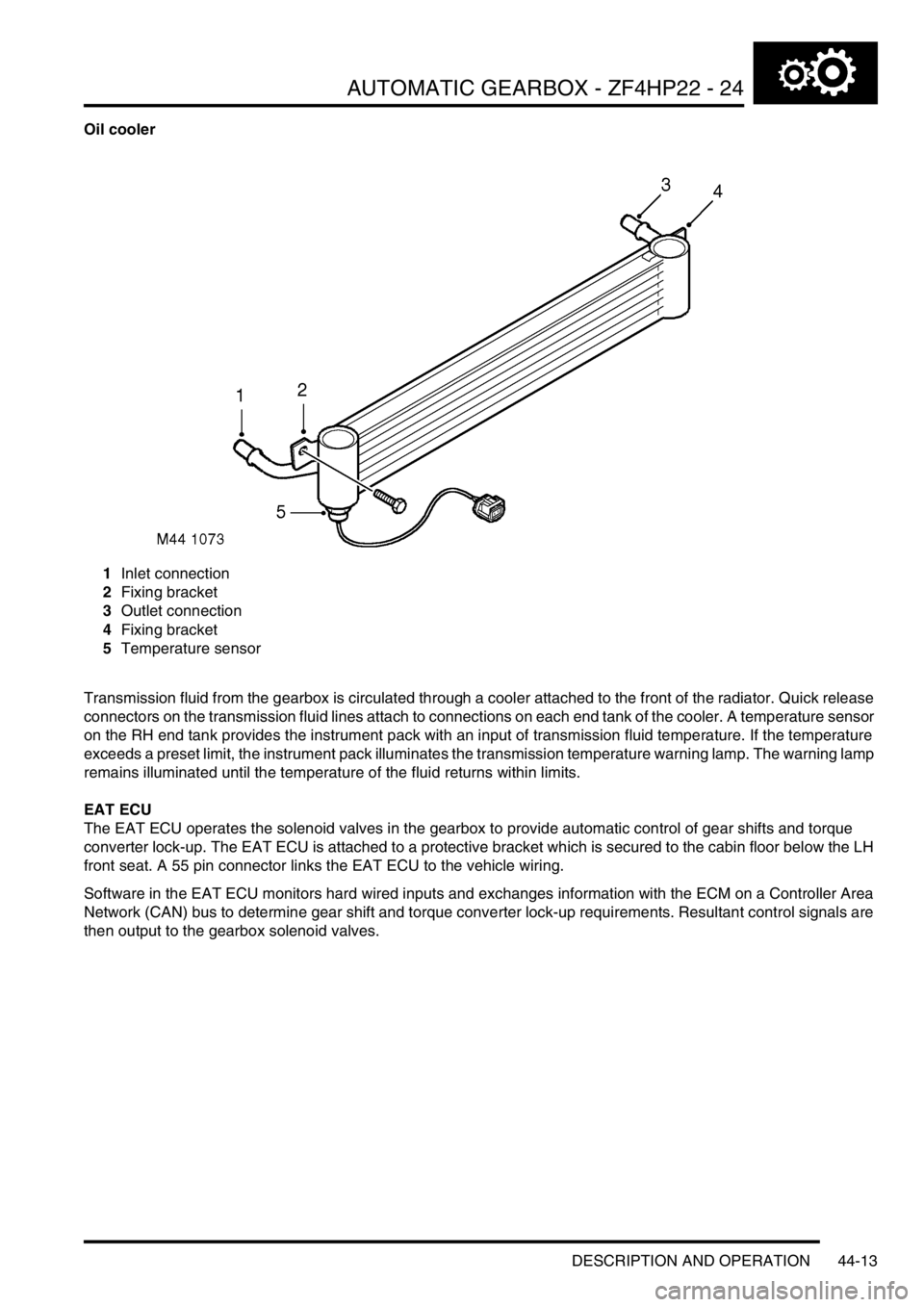warning LAND ROVER DISCOVERY 2002 Owners Manual
[x] Cancel search | Manufacturer: LAND ROVER, Model Year: 2002, Model line: DISCOVERY, Model: LAND ROVER DISCOVERY 2002Pages: 1672, PDF Size: 46.1 MB
Page 748 of 1672

TRANSFER BOX - LT230SE
DESCRIPTION AND OPERATION 41-15
High/low detect switch
A high/low detect switch is fitted in the front output housing and connects to earth when low is selected. The switch is
connected to the engine ECM, the SLABS ECU and the EAT ECU. The purpose of the switch is to enable selection
of the hill descent feature and to modify the engine fuelling and automatic gearbox gearshift maps stored within the
respective ECM's and ECU's.
Differential lock - Fitted to certain vehicles only
The differential lock selector housing is bolted to the top of the front output housing, the selector finger passes through
the housing, locating in a slot in the differential lock selector shaft. The differential lock selector shaft passes through
the selector fork which is located beneath a plate bolted to the side of the output housing. The selector fork engages
the dog clutch sleeve with the differential rear shaft when the splines of the sleeve and differential rear shaft are
aligned. A spring loaded detent ball fitted in the output housing locates in grooves in the shaft.
Functionality – Vehicles up to 03 model year only
The function of the differential lock used in previous applications is performed on this vehicle by the Electronic Traction
Control System. However, for the purposes of 2 wheel rolling road testing , the differential lock components are
retained. For all driving conditions however, the differential lock must be set in the unlocked position.
Up to 03 model year specification shown
The differential lock must only be engaged for 2 wheel rolling road testing as engagement of the lock disables the
traction control feature and inhibits correct operation of the electronic brake distribution and hill descent features. It
will also be necessary to disconnect the propeller shaft from the transfer box output shaft driving the axle whose
wheels are NOT on the rolling road. The lock may be engaged/disengaged by using a 10 mm open ended spanner
on the flats (arrowed) machined on the differential lock selector shaft.
Vehicles not fitted with a differential lock may be identified by there being no cover or selector shaft (arrowed) on the
front output housing.
WARNING: VEHICLES NOT FITTED WITH A DIFFERENTIAL LOCK MUST NOT BE TESTED ON A ROLLING
ROAD WHERE THE ROLLERS ARE DRIVEN BY THE VEHICLE.
Page 749 of 1672

TRANSFER BOX - LT230SE
41-16 DESCRIPTION AND OPERATION
Functionality – Vehicles from 03 model year only
The differential lock must be engaged for 2 wheel rolling road testing. It will also be necessary to disconnect the
propeller shaft from the transfer box output shaft driving the axle whose wheels are NOT on the rolling road. In
addition, the ETC system must be deactivated by either, removing a fuse (10A fuse 28 in the passenger compartment
fusebox, labelled ABS) or disconnecting the ABS modulator pump. This must be done with the ignition switched off.
Note that the SLABS ECU may record a system fault.
The lock can be engaged or disengaged using the selector lever. Vehicles not fitted with a differential lock can be
identified by a high/low range selector lever with no differential lock functionality and the cover and selector shaft
(arrowed), not visible on the front output housing.
WARNING: VEHICLES NOT FITTED WITH A DIFFERENTIAL LOCK MUST NOT BE TESTED ON A ROLLING
ROAD WHERE THE ROLLERS ARE DRIVEN BY THE VEHICLE.
Differential lock warning lamp switch - if fitted - Vehicles up to 03 model year
A differential lock warning lamp switch connected to the SLABS ECU and operated by movement of the selector fork
and shaft is screwed into the top of the output housing. The switch connects to earth when the differential lock is
engaged.
Differential lock warning lamp switches - if fitted - Vehicles from 03 model year
Vehicles from 03 model year are fitted with two differential lock warning lamp switches.
One switch is of a new design and is fitted into the top of the front output housing in the same position as on previous
models. The switch is connected to the SLABS ECU and is operated by movement of the selector fork and shaft.
The second switch is located in a threaded hole on the forward face of the front output housing. The switch is also
connected to the SLABS ECU and is operated by movement of the selector shaft.
Both switches have an aluminium washer which seals the switch to the casing and also sets the switch position,
removing the requirement for a setting procedure.
Both switches are connected in parallel to earth when the differential lock is engaged. This earth is sensed by the
SLABS ECU which illuminates the differential lock warning lamp in the instrument pack.
Differential lock warning lamp - Vehicles up to 03 model year – if fitted
The differential lock warning lamp is located in the instrument pack and provides a warning to the driver when the
ignition is switched on that the differential lock is engaged. The warning lamp illuminates in a Red colour.
With the lock engaged, the traction control and electronic brake distribution warning lamps will also be illuminated.
Disengagement of the differential lock should be carried out with the ignition switched off. The warning lamps must
be extinguished when the ignition is switched on again.
Differential lock warning lamp – vehicles from 03 model year – if fitted
The differential lock warning lamp is located in the instrument pack and provides a visual warning to the driver, when
the ignition is on, the differential lock is engaged. The warning lamp illuminates in an amber colour.
When the lock is engaged, the warning lamp is illuminated and the instrument pack sounder emits three audible
chimes. When the lock is disengaged, the warning lamp is extinguished and the instrument pack sounder emits three
audible chimes.
Rear output housing
The rear output housing carries the output shaft and flange. A cable operated transmission brake is attached to the
housing, the brake drum being attached to the output flange.
The rear output shaft is supported in the housing by a single bearing and is splined into the differential rear sun gear.
Page 750 of 1672

TRANSFER BOX - LT230SE
DESCRIPTION AND OPERATION 41-17
Lubrication
Lubrication is by splash, oil filler/level and drain plugs being located in the main casing.
Internal pressures caused by thermal expansion and contraction are avoided by the use of a plastic breather pipe
venting the interior of the box to atmosphere. The pipe is attached to the top of the high/low selector housing by a
banjo bolt and is then routed in a continuously rising path into the engine compartment where the open end is secured
by a clip attached to the engine cylinder block.
Oil temperature warning lamp switch
An oil temperature switch is fitted to V8 engine models. In the event of the transfer box oil approaching maximum
recommended working temperature of 145
°C (293°F), the switch will close and a warning lamp in the instrument pack
will be illuminated.
High/Low range and differential lock selector lever assembly – Vehicles from 03 model year
1Selector lever
2High/Low range cable
3Differential lock cable
4Interlock solenoid
Page 770 of 1672

TRANSFER BOX - LT230SE
REPAIRS 41-37
Sensor - oil temperature
$% 41.20.80
Remove
1.Lower vehicle.
2.Disconnect 2 Lucar connectors from oil
temperature sensor.
3.Remove oil temperature sensor and discard
sealing washer.
Refit
1.Clean sensor and mating face on transfer box.
2.Fit new sealing washer, position oil
temperature sensor and tighten to 42 Nm (31
lbf.ft).
3.Connect Lucar connectors to oil temperature
sensor.
4.Lower vehicle.
Switch - high low - warning
$% 41.30.05
Remove
1.Raise vehicle on a ramp.
2.Release switch multiplug from bracket on
transfer box and disconnect from harness.
3.Remove switch from transfer box and discard
sealing washer.
Refit
1.Ensure sealing washer, switch thread and
mating face on transfer box is clean.
2.Fit sealing washer to switch, fit and tighten
switch to transfer box to 26 Nm (19 lbf.ft) .
3.Connect multiplug to harness and fit multiplug
to bracket on transfer box.
4.Lower vehicle.
Page 776 of 1672

TRANSFER BOX - LT230SE
OVERHAUL 41-43
4.Remove 3 bolts securing differential lock
selector housing and remove housing.
5.Remove and discard 'O' ring from selector
housing.
6.Remove Allen plug and remove detent spring
and ball.
7.Remove differential lock warning lamp switch
and locknut.
Note: Locknut is only fitted to switches up to 03
MY, a modified switch and sealing washer is
fitted from 03 MY onwards.
8.03 MY onwards: Remove differential lock
warning lamp switch from end of front output
shaft housing, discard sealing washer.
9.Compress differential lock selector fork spring
and remove retaining clips from each end of
spring.
10.Withdraw differential lock selector shaft from
front output housing, recover spring and
remove selector fork.
Note: Carry out the following operations for all
transfer boxes.11.Position tool LRT-51-003 to output shaft drive
flange, remove and discard nut, steel and felt
washers; remove output shaft drive flange.
12.Using a copper mallet, drive output shaft from
housing, recover bearing spacer.
13. If fitted: Noting its fitted position, remove dog
clutch from output shaft.
Page 789 of 1672

TRANSFER BOX - LT230SE
41-56 OVERHAUL
48.Compress selector spring and fit retaining clips
at each end of spring.
CAUTION: Ensure ends of spring are fully
seated in recess of clips.
49.Fit detent ball and spring.
50.Apply Loctite 290 to threads of detent plug.
51.Fit and tighten detent plug, then loosen 2
complete turns.
52.Fit new 'O' ring to differential lock selector
housing.
53.Fit selector housing, ensure selector finger is
located in shaft recess.
54.Apply Loctite 290 to threads of bolts, and
tighten selector housing bolts to 25 Nm (18
lbf.ft).
55.Clean threads of differential lock warning lamp
switch(es).
56.Up to 03 MY: Fit nut to switch head with
counterbore positioned towards switch head.
The nut acts as a spacer to ensure that
switch setting is correct. Always ensure
that nut is fully tightened to switch head (no
gap).
57.Apply Hylomar PL 32 sealant to threads of
differential warning lamp switch(es).
58.Up to 03 MY: Position switch into front output
housing until nut bottoms out on housing;
tighten nut to 11 Nm (8 lbf.ft)
59.03 MY onwards: Fit new sealing washers to
switches, fit switches in front output housing
and tighten to 25Nm (18 lbf.ft).
Note: Carry out the following operations for all
transfer boxes.
60.Apply sealant, Part No. STC 3254 to front
output shaft housing. 61.Position housing ensuring that output shaft and
dog clutch splines - if fitted are correctly
engaged.
62.Clean output housing bolt threads.
63.Apply Loctite 290 to threads of bolts.
64.Fit output shaft housing bolts and tighten in a
diagonal sequence to 45 Nm (33 lbf.ft).
65.Fit output flange, new felt washer, steel washer
and new retaining nut.
66.Using tool LRT-51-003 to restrain flange,
tighten output flange nut to 162 Nm (119 lbf.ft).
67. If fitted - Operate differential lock selector
lever and check that detent ball can be felt to
positively engage/disengage with grooves in
shaft. Screw plug in or out until setting is
correct.
68.Fit high/low selector shaft detent ball and
spring.
69.Apply Loctite 290 sealant to threads of high/low
selector shaft detent plug.
70.Fit and tighten plug, then loosen 2 complete
turns.
71. Operate high/low selector lever and check that
detent ball can be felt to positively engage/
disengage with grooves in shaft. Screw plug in
or out until setting is correct.
72.Fit intermediate gear cluster.
+ TRANSFER BOX - LT230SE,
OVERHAUL, Intermediate gear assembly.
Page 790 of 1672

TRANSFER BOX - LT230SE
OVERHAUL 41-57
Dog clutch - differential lock
$% 41.20.23
Disassembly
1.Remove 6 bolts securing high/low cross shaft
housing to front output shaft housing and
remove housing.
2.Note position of longest bolt and remove 8
bolts securing front output shaft housing to
main casing and remove housing.
3.Remove 3 bolts securing differential lock
selector housing and remove housing. 4.Remove and discard 'O' ring from selector
housing.
5.Remove differential warning lamp switch and
locknut.
Note: Locknut is only fitted to switches up to 03
MY, a modified switch and sealing washer is
fitted from 03 MY onwards..
6.03 MY onwards: Remove differential lock
warning lamp switch from end of front output
shaft housing, discard sealing washer.
7.Remove Allen plug and remove detent spring
and ball.
8.Compress differential lock selector fork spring
and remove retaining clips from each end of
spring.
9.Withdraw differential lock selector shaft from
front output housing, recover spring and
remove selector fork.
Page 792 of 1672

TRANSFER BOX - LT230SE
OVERHAUL 41-59
21.Clean threads of differential lock warning lamp
switch(es).
22.Up to 03 MY: Fit nut to switch head with
counterbore positioned towards switch head.
The nut acts as a spacer to ensure that
switch setting is correct. Always ensure
that nut is fully tightened to switch head (no
gap).
23.Apply Hylomar PL 32 sealant to threads of
differential warning lamp switch(es).
24.Up to 03 MY: Position switch into front output
housing until nut bottoms out on housing,
tighten nut to 11 Nm (8 lbf.ft).
25.03 MY onwards: Fit new sealing washers to
switches, fir switches to front output housing
and tighten to 25 Nm (18 lbf.ft).
26.Operate differential lock selector lever and
check that detent ball can be felt to positively
engage/disengage with grooves in shaft.
Screw plug in or out until setting is correct.27.Fit output flange, new felt and steel washers
and new retaining nut.
28.Using tool LRT-51-003 to restrain flange,
tighten output flange nut to 162 Nm (119 lbf.ft).
Page 801 of 1672

AUTOMATIC GEARBOX - ZF4HP22 - 24
44-4 DESCRIPTION AND OPERATION
Description
General
The automatic gearbox is a four speed unit with electronic control of gear selection, shift quality and torque converter
lock-up. Selections on the selector lever assembly are transmitted to the gearbox by a selector cable. A gear position
switch on the gearbox transmits the gear selection to an Electronic Automatic Transmission (EAT) ECU, which
outputs the appropriate control signals to an electro-hydraulic valve block in the gearbox. A mode switch enables the
driver to change the control mode of the EAT ECU. The EAT ECU operates warning lamps in the instrument pack to
indicate the control mode and system status.
The gearbox features a pressure lubrication system and is cooled by pumping the lubricant through an oil cooler.
On NAS market vehicles from 03 model year, the ZF 4HP24 transmission unit is introduced for use with the 4.6 litre
V8 engine. This transmission is required to accomodate the increased power output of the larger engine. The ZF
4HP22 transmission remains in use on vehicles with Td5 and 4.0 litre V8 engines.
Both transmission units are of similar construction, with the ZF 4HP24 unit being 15 mm longer than the 4HP22 unit
to accomodate a larger fluid pump. The operation of both transmission units is the same.
Selector lever assembly
Page 810 of 1672

AUTOMATIC GEARBOX - ZF4HP22 - 24
DESCRIPTION AND OPERATION 44-13
Oil cooler
1Inlet connection
2Fixing bracket
3Outlet connection
4Fixing bracket
5Temperature sensor
Transmission fluid from the gearbox is circulated through a cooler attached to the front of the radiator. Quick release
connectors on the transmission fluid lines attach to connections on each end tank of the cooler. A temperature sensor
on the RH end tank provides the instrument pack with an input of transmission fluid temperature. If the temperature
exceeds a preset limit, the instrument pack illuminates the transmission temperature warning lamp. The warning lamp
remains illuminated until the temperature of the fluid returns within limits.
EAT ECU
The EAT ECU operates the solenoid valves in the gearbox to provide automatic control of gear shifts and torque
converter lock-up. The EAT ECU is attached to a protective bracket which is secured to the cabin floor below the LH
front seat. A 55 pin connector links the EAT ECU to the vehicle wiring.
Software in the EAT ECU monitors hard wired inputs and exchanges information with the ECM on a Controller Area
Network (CAN) bus to determine gear shift and torque converter lock-up requirements. Resultant control signals are
then output to the gearbox solenoid valves.